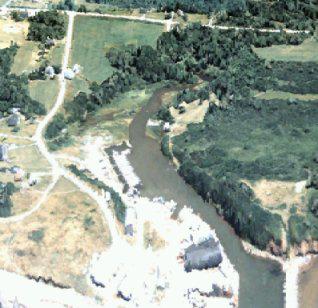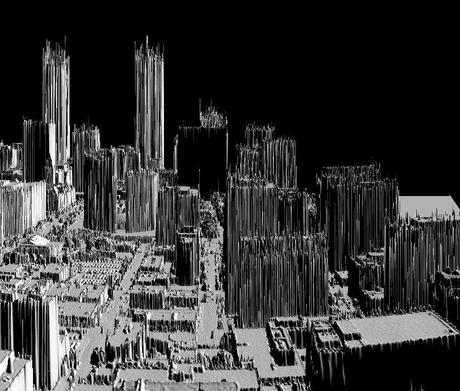 Digital Terrain Modeling is the process of simulating or representing the relief and patterns of a surface with numerical and digital methods. It has always been an integral component to geology related fields such as geomorphology, hydrology, tectonics and oceanography but over the past decade has also become a major component to non geophysical applications such as GIS modeling, surveying and land use planning.
Digital Terrain Modeling is the process of simulating or representing the relief and patterns of a surface with numerical and digital methods. It has always been an integral component to geology related fields such as geomorphology, hydrology, tectonics and oceanography but over the past decade has also become a major component to non geophysical applications such as GIS modeling, surveying and land use planning.
Sometimes commonly known as quantitative geomorphology, digital terrain modeling is thecomputer processing of raster grid arrays of elevation data. Using Geographic information system (GIS) technology we can further enable terrain-modeling results to be combined with non topographic spatial data creating several value added products.
Terrain Models are derived from data represented by digital elevation models (DEMs) and can include shaded relief models,
slope and aspect models, perspective scene generation, and drainage basin analysis (and other models).
The physiogeographic characteristics of a surface can often be determined by elevation, slope, and its orientation, or aspect. Together they can virtually define the surface plane completely, and provide valuable information for land use planning and other aspects of geomatics.
Traditional images in geomatics are often two dimensional, meaning that all data in the image can be referenced by X and Y coordinates. Three dimensional images (3-D) incorporate a third dimension (the Z component) which represents the elevation or depth aspect of the data. To incorporate it into an image requires creating special geomatics value added products that allow users to perceive the presence of the third dimension into a traditional two dimensional setting
(because most paper and computer screens are flat or two dimensional).

Shaded relief models use a defined light source at a fixed location it indicate terrain displacements using a shadow effect from evaluating the aspect and slope relative to the light’s azimuth angle and altitude achieved with varying gray scale tones resulting in the darkening of one side of terrain features, such as hills and ridges (the darker the shading, the steeper the slope).
The shadow direction is affected by the light’s azimuth setting and shadow length is affected by the altitude component. The models provide subtle shadings which we naturally perceive as depth, helping to make the image look three dimensional. A drawback with this type of model is that depending on the placement of the illumination source, the eye and brain often see different things. Adding color to the shaded relief images utilizes chromo stereoscopic techniques to help emphasize the depth of the Z dimension of the data.
Color shaded relief models (CSR) are usually graded with a pseudo color ramp from cooler (darker) colors representing
lower elevations to warmer (brighter) colors depicting greater elevations. Most imagery and data that we view in geomatics is typically viewed vertical downwards toward the map or image. Occasionally it is useful to change that default traditional view because additional topographic information can often be revealed by observing the same elevation data obliquely (commonly known as a three dimensional perspective view). Data integration and overlays are very common with perspective views because it allows traditional flat images to become new products by incorporating an elevation component and providing a new look at the same data. It is also probably used more so for visual appeal then as another method of extracting data.

The perspective scene in the image on the left is a representation of an urban terrain model including buildings and other various features. It was created using ESRI ArcScene software and high resolution LIDAR digital point data. The artificial oblique view allows the observer to obtain a unique glimpse from above looking down in a southerly direction towards City Hall of downtown Toronto, Ontario.
More information on Terrain modeling and examples
- MacKinnon E (2003) Surface Modeling and LIDAR Validation Middleton, Nova Scotia: Applied Geomatics Research Group, Centre of Geographic Sciences, 49 pages
- MacKinnon E (2004) Three Dimensional Flood Modeling with High Resolution LIDAR (Graduate Thesis) Middleton, Nova Scotia: Applied Geomatics Research Group, Centre of Geographic Sciences, 200 pages
- MacKinnon E (2005) Three Dimensional Flood Modeling with High Resolution LIDAR (2005 CIG Conference Proceeding) Ottawa, Ontario:Canadian Institute of Geomatics, 8 pages
- MacKinnon E, Sangster F & Hynes D (1999) Geological Data Integration: Makkovik, Labrador Lawerncetown, Nova Scotia: Centre of Geographic Sciences, 12 pages
- MacKinnon E (2004) 3D Modeling with High Resolution LIDAR - presented at the GeoTec Conference in Toronto,Ontario and displayed at the Applied Geomatics Research Group in Middleton, Nova Scotia
- MacKinnon E (2004) Bouctouche, NewBrunswick – Color Shaded Relief - presented at CCAF annual general meeting held at the University of Moncton in Moncton, New Brunswick, and displayed at the Applied Geomatics Research Group in Middleton, Nova Scotia
- MacKinnon E (2004) FLood Simulation Modeling with High Resolution LIDAR - presented at CCAF annual general meeting held at the University of Moncton in Moncton, New Brunswick, and displayed at the Applied Geomatics Research Group in Middleton, Nova Scotia
- McCurdy C, MacKinnon E & Lynds T (1999) Integration of Digital elevation Models and Imagery : Terrain Analysis of the Antigonish Highlands - presented at the Center of Geographic Sciences in Lawrencetown, Nova Scotia
- Digital Elevation Models (DEMs)
- Shaded Relief Models
- Color Shaded Relief Models (CSR)
- Creating a CSR model in Geomatica v9.1
- Slope Models
- Aspect Models
- Perspective View Models

